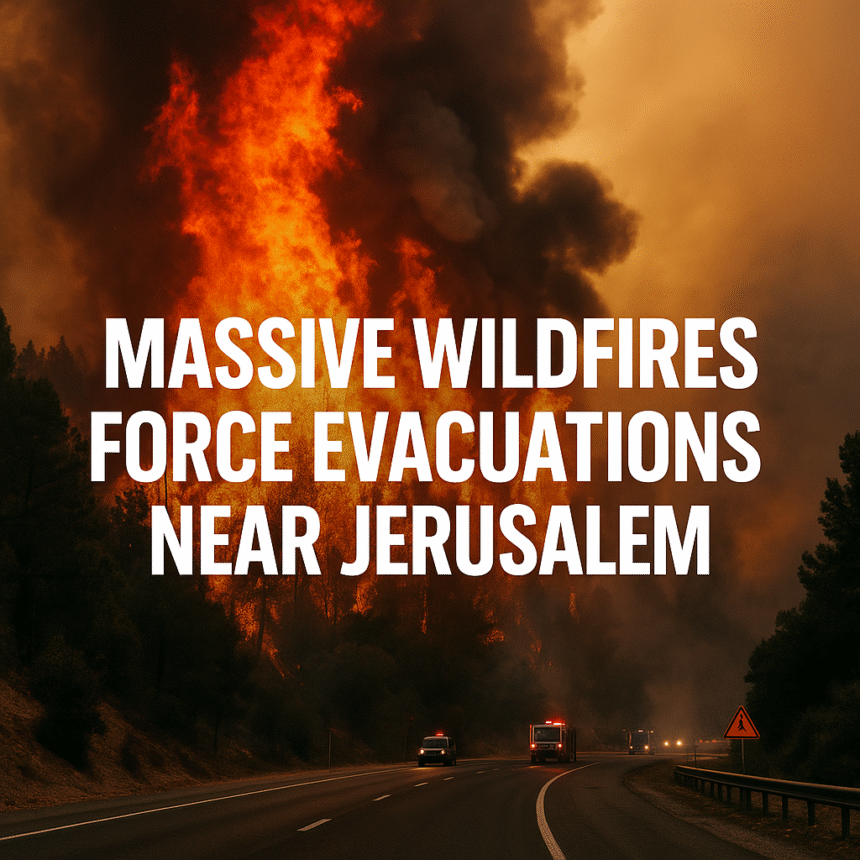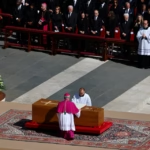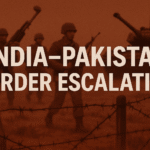In a terrifying turn of events, Israel is grappling with one of the most destructive wildfires in its recent history. The blaze, which began on April 30, 2025, west of Jerusalem, has rapidly spiraled into a national emergency, forcing mass evacuations and threatening both human lives and critical infrastructure.
🔺 The Firestorm Unfolds: A Nation on Alert
Low humidity, dry conditions, and high winds have created the perfect storm for what officials now fear could be the largest wildfire Israel has ever recorded. The flames reportedly ignited in the forested region between Eshtaol and Latrun — popular nature areas west of the capital — before spreading uncontrollably toward Beit Shemesh and the outskirts of Jerusalem itself.
Local authorities and fire experts have described the pace of the fire’s spread as “unprecedented.” According to the Israel Fire and Rescue Services, more than 160 firefighting teams have been deployed across the region, including airborne support and military units.
“We are in a race against time,” stated Commissioner Eyal Caspi, head of Israel’s fire services. “The winds are unpredictable, and our primary goal is to save lives.”
🚨 Mass Evacuations and Road Closures
As smoke and flames reached residential zones, emergency services began a mass evacuation of affected neighborhoods. Residents from several communities, including Mevaseret Zion, Beit Meir, and parts of Beit Shemesh, were instructed to evacuate immediately.
Highway 1, the vital transportation link between Tel Aviv and Jerusalem, was closed in both directions. Eyewitness reports from the scene describe a harrowing scenario as motorists abandoned vehicles and fled on foot to escape the encroaching inferno.
“We were on our way to Jerusalem when everything turned black with smoke. It was panic everywhere,” said one evacuee.
🏥 Health Risks: Smoke Inhalation and Medical Response
At least 12 people have been hospitalized so far, primarily for smoke inhalation and minor burns. Local clinics and hospitals have activated emergency protocols, and field clinics have been set up for triage near evacuated zones.
Firefighting personnel are also at risk, working in extreme heat and exposure. First responders are being rotated regularly to avoid heatstroke and respiratory distress.
🪖 Military Involvement and National Response
In a rare move, Defense Minister Israel Katz ordered full military support for civilian firefighting efforts. This includes military helicopters, logistical aid, and additional manpower.
Prime Minister Benjamin Netanyahu has convened an emergency cabinet session and vowed to use “every available resource” to contain the crisis.
🇮🇱 Independence Day Ceremony Cancelled
Adding a layer of symbolic gravity to the situation, Israel’s official Independence Day ceremony at Mount Herzl has been cancelled for the first time in decades. Traditionally a highly patriotic event, this year’s gathering was replaced by a pre-recorded broadcast to avoid endangering attendees.
🔎 Suspected Arson: Arrests Made
Adding a chilling twist, Israeli Police have arrested three individuals suspected of starting the fires deliberately. While investigations are ongoing, early reports suggest evidence of arson-related activity in multiple ignition points. If confirmed, the incident could have political and security implications, especially given the current tensions in the region.
“We are treating this not only as an environmental disaster but as a potential criminal act,” said Police Chief Kobi Shabtai.
🌿 Environmental Impact: Forests Lost Forever?
The forests of Latrun and Eshtaol are known for their ecological diversity, hiking trails, and cultural heritage. Early assessments estimate over 3,500 acres of woodland have been reduced to ash in just 24 hours.
Local wildlife, including endangered species, have also suffered. Videos shared online show injured deer, foxes, and birds fleeing the fire zones.
Israeli environmental groups are calling for international assistance and future policy reforms to prevent such disasters from recurring.
📉 Tourism and Economic Fallout
Tourism sites in the affected areas have closed indefinitely. Tour operators report mass cancellations from foreign visitors who had planned trips to heritage parks, hiking trails, and religious landmarks near Jerusalem.
Experts warn that this event could also impact agriculture and water supply in the region, as natural water reservoirs and irrigation lines have been damaged.
🕯️ Memorial Day Disruptions
With Memorial Day (Yom HaZikaron) ceremonies planned across the country, especially at military cemeteries, the ongoing wildfire presents significant logistical challenges. Some events have already been postponed, and the IDF is coordinating with municipalities to ensure safety for those commemorating the nation’s fallen.
📱 Social Media Reactions: “This is Our Paradise Burning”
Online platforms are flooded with videos of blazing hillsides, emergency convoys, and emotional testimonies from evacuees. The hashtag #JerusalemFire has trended globally on X (formerly Twitter), Instagram, and TikTok.
Notable reactions include:
- 🇮🇱 Gal Gadot, Israeli actress, posted: “My heart breaks for the forests I grew up hiking through. Praying for the brave responders.”
- 🌍 UN Environment Programme: “Monitoring the Israeli wildfire crisis closely. We offer support as needed.”
🔦 What Comes Next?
As of the time of publication, fire containment remains a challenge due to changing wind patterns and the sheer scale of the disaster. Authorities continue to urge residents to stay indoors or evacuate when instructed.
A special task force has been established to coordinate international firefighting assistance, particularly from nations experienced in large-scale wildfires like the U.S., Australia, and Greece.






